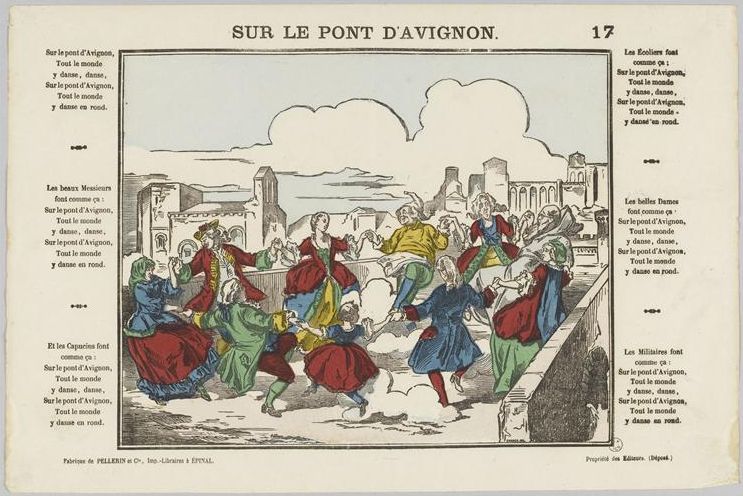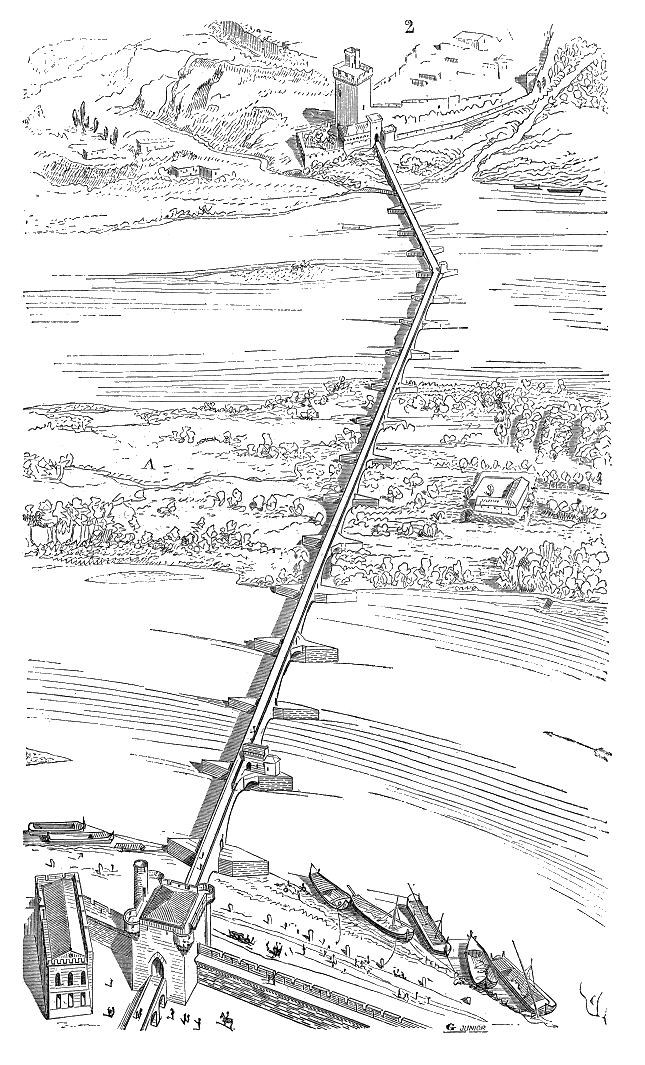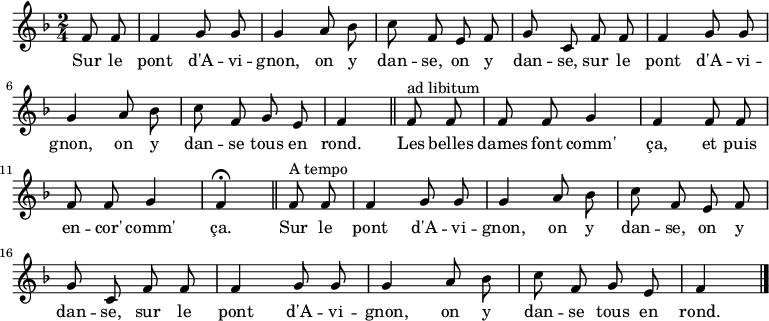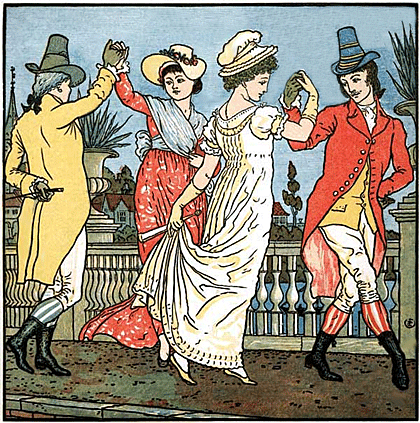Sur le pont d'Avignon is a traditional French song dating to the 15th century. The mimed ronde involves all sorts of characters dancing around or on the famous bridge Pont Saint-Bénézet in Avignon.
The story of the song
Some scholars date the song back to at least the 15th century.
However, neither the author nor the origin of the song is known, but it became popular in 1853 when the composer Adolphe Adam included it in his comic opera, Le Sourd ou l'Auberge pleine.

Sur le pont d'Avignon. Illustration from the 19th c
The bridge of Avignon
The song refers to a bridge (the one in Avignon) that still exists today: the Saint-Bénézet bridge.
However, this bridge has not joined the other bank of the Rhône since the 17th century, following a succession of floods which caused it to collapse. Of the original 22 arches, only 4 remain today.

The bridge of Avignon spanning the Rhône in the Middle Ages
The only bridge between Lyon and the sea
When it was completed in 1185, twenty-two arches spanned the Rhône, forming a curve 920 metres long and four metres wide.
For a long time, it was the only bridge to cross the Rhône between Lyon and the Mediterranean Sea.
However, its use was very specific. It allowed for efficient traffic control and the collection of tolls, in accordance with its role as a border post between the Papal State and the Kingdom of France.

General view of Avignon General View - Stock Photos from saiko3p : Shutterstock
A bridge too narrow to dance on!
If you have the opportunity to visit the bridge today, you will notice that it is very narrow.
In the Middle Ages, it was too narrow to allow carts to pass each other. As a result, goods had to be transported between the two banks of the Rhône by boat or barge. So it could never be used for purely commercial purposes.
Of course, the bridge was too narrow to dance a ronde on.
The dances were originally done on the banks, which is why some old-timers still refer to the song as "sous le pont d'Avignon" (under the bridge of Avignon) and not "sur le pont" (on the bridge).
Two chapels on the bridge!
The present bridge still shelters two medieval chapels. On one of the pillars is the Saint-Bénézet chapel, and above it, the Saint-Nicolas chapel.

The 'Pont d'Avignon' (St. Bénezet bridge) and the chapels © French Moments
Sur le pont d'Avignon
Lyrics, music, free download... let's learn more about the popular song:

A very easy song to remember!
The melody of the chorus is very simple and easy to remember because of its first notes:
- two quavers (C,C)
- one crotchet (C)
- two quavers (D,D)
- one crotchet (D)
The lyrics in French
The original song of Sur le pont d'Avignon has a chorus and at least two famous verses introducing "beaux messieurs" and "belles dames".
Refrain
Sur le pont d'Avignon,
On y danse, on y danse,
Sur le pont d'Avignon,
On y danse, tous en rond.
Couplet 1
Les beaux messieurs font comme ça,
Et puis encore comme ça.
Couplet 2
Les belles dames font comme ça,
Et puis encore comme ça.
Translation of the lyrics into English
Here is an approximative translation into English:
Verse 1
On the bridge of Avignon,
We dance there, we dance there,
On the bridge of Avignon,
We dance there, all in a circle.
Verse 2
Handsome men do it like this,
And then again like this.
Verse 3
Beautiful ladies do it like this,
And then again like this.

Sur le pont d'Avignon. Illustration by Walter Crane
An endless song!
The song is endless! Indeed, as many verses as one wants can be invented and dedicated to other trades or to various characters. This makes the nursery rhyme an ideal song for teaching children the vocabulary of professions in French.
For example, you can add the following:
- Les avocats font comme ça... (lawyers)
- Les boulangers font comme ça... (bakers)
- Les blanchisseuses font comme ça... (washerwomen)
- Les cordonniers font comme ça... (shoemakers)
- Les couturiers font comme ça... (dressmakers)
- Les gendarmes font comme ça... (policemen)
- Les jardiniers font comme ça... (gardeners)
- Les musiciens font comme ça... (musicians)
- Les soldats font comme ça... (soldiers)
- Les vignerons font comme ça... (winegrowers)
- etc.
The kids movements of the song
The refrains are generally associated with the round itself, while the verses, more loosely spoken, correspond to the miming episodes:
- The children dance in a circle to the chorus.
- On the first verse (les beaux messieurs), the children stop dancing and bow, pretending to lift their imaginary hats.
- On the second verse (les jolies dames), they bow to one side and then to the other.


